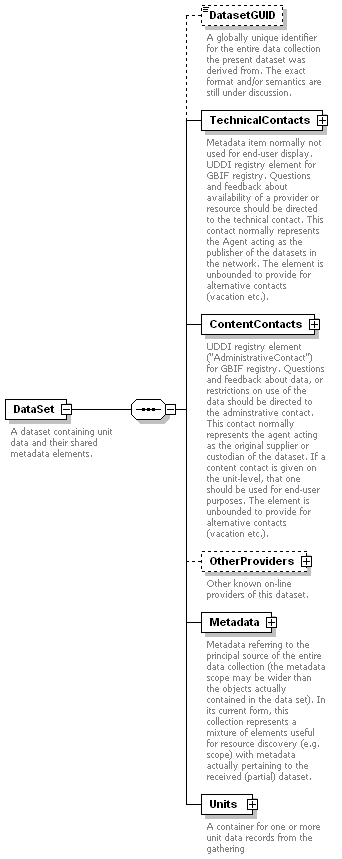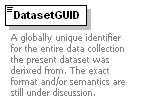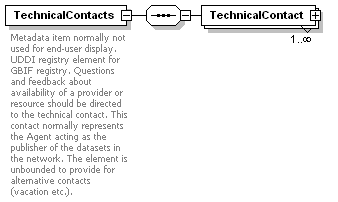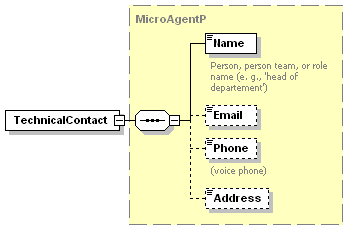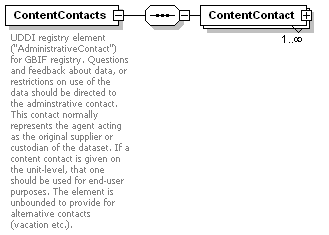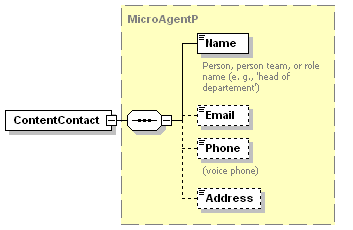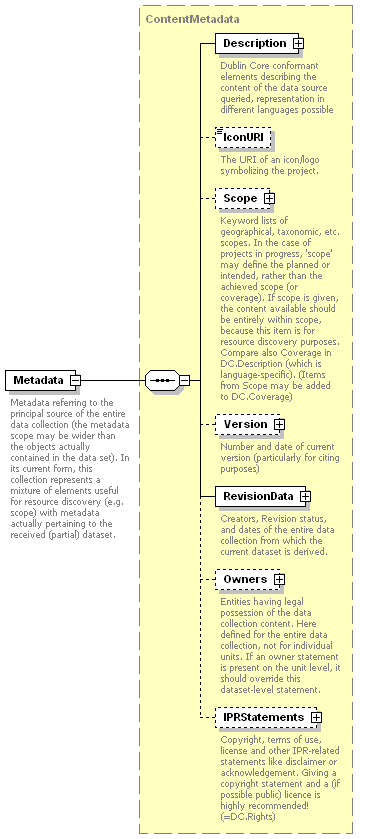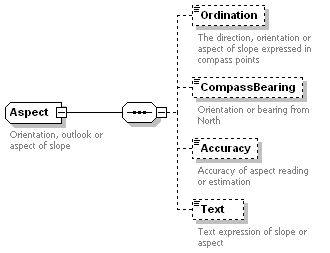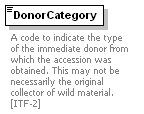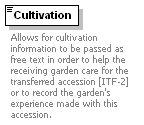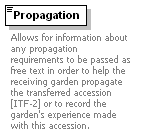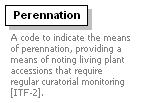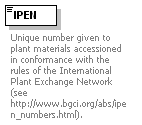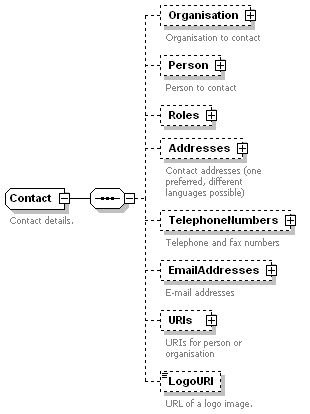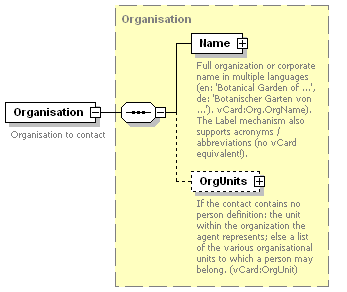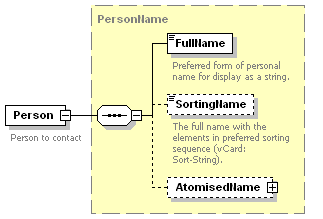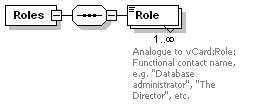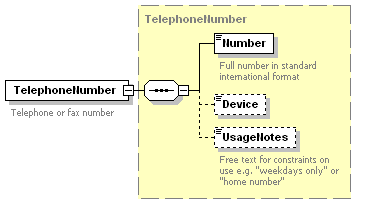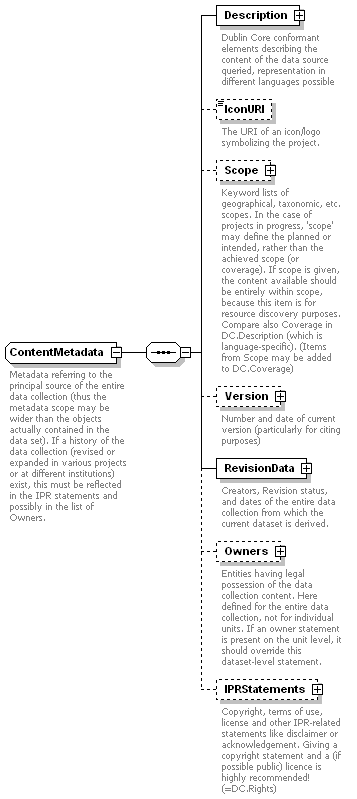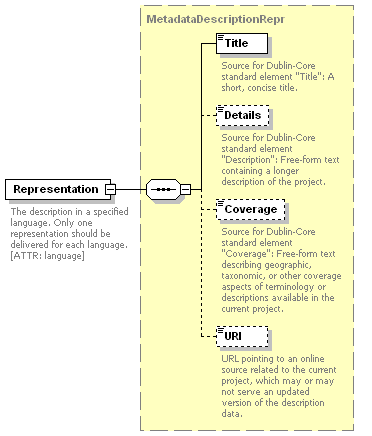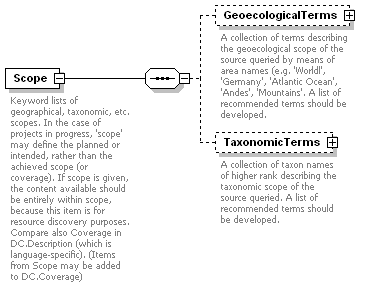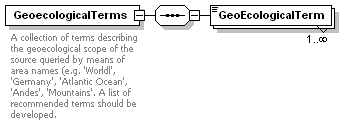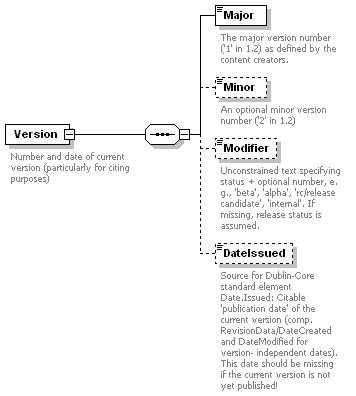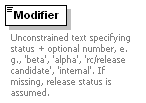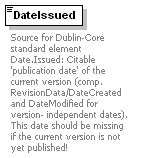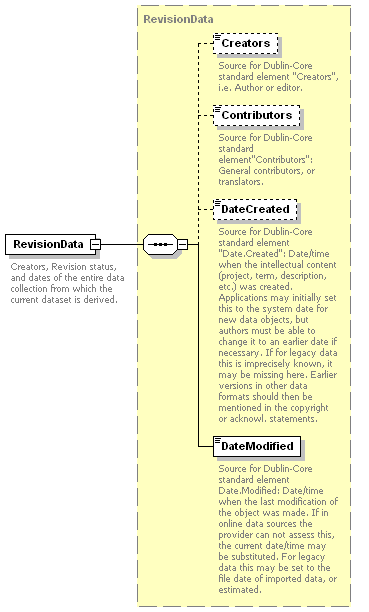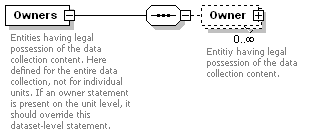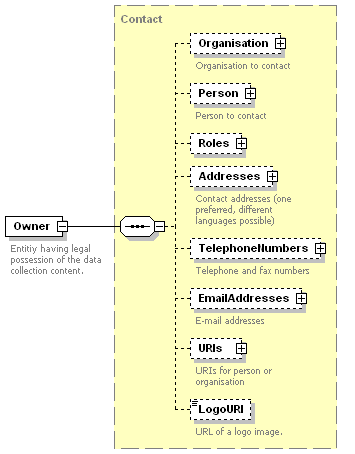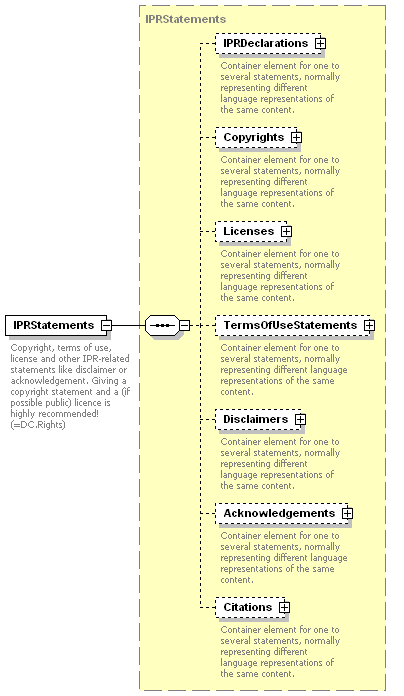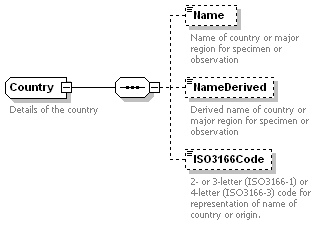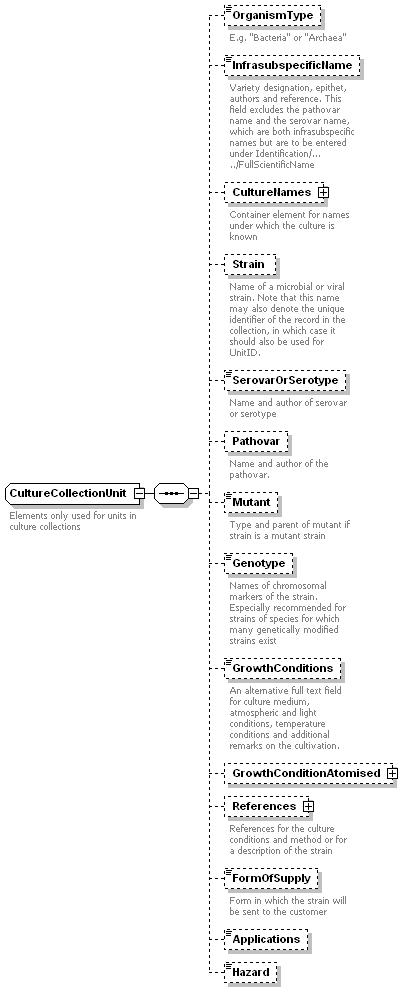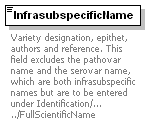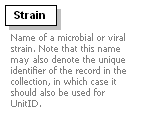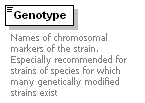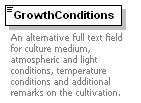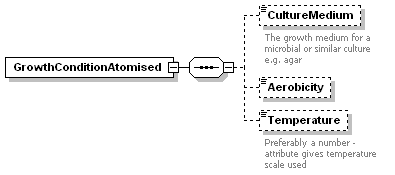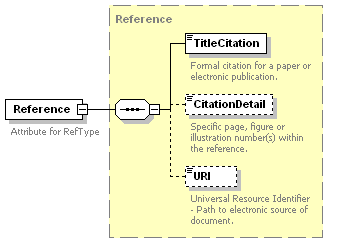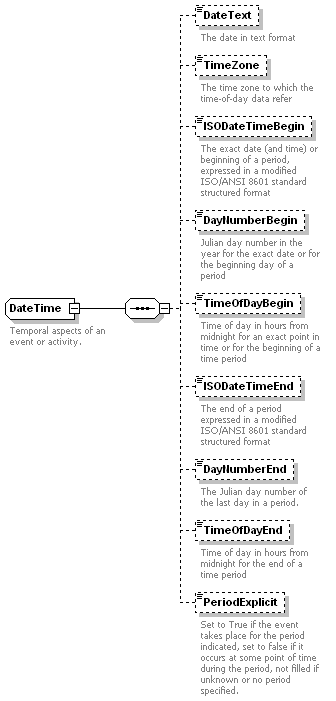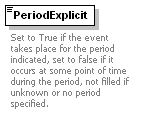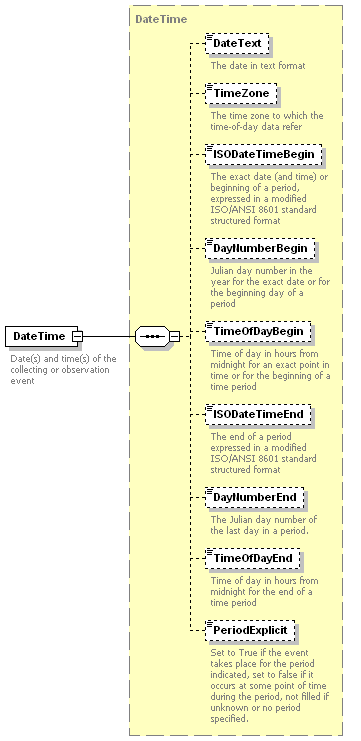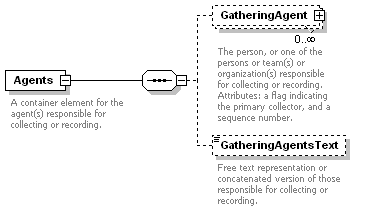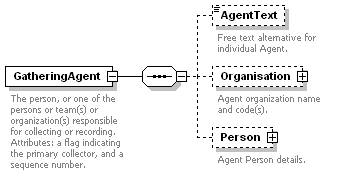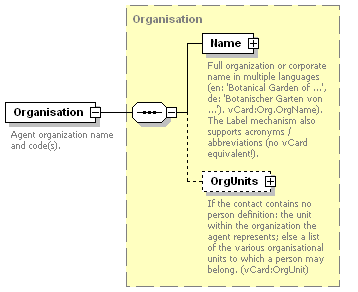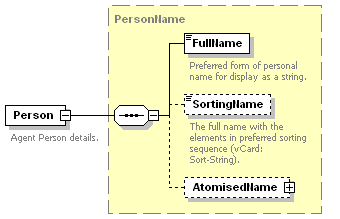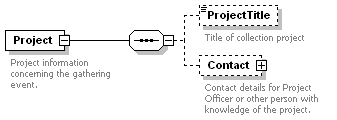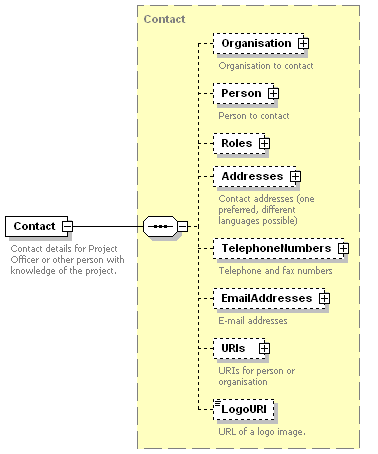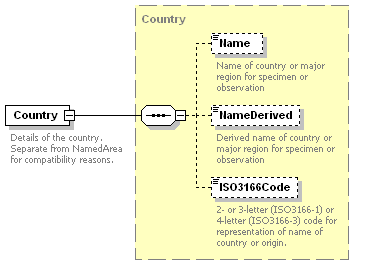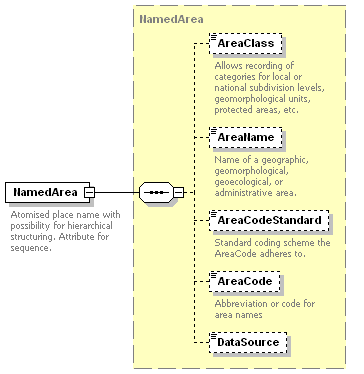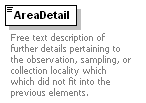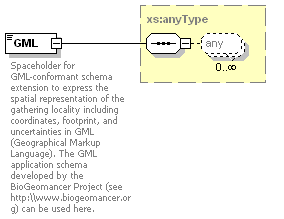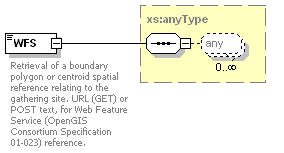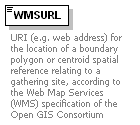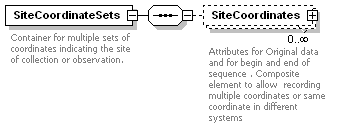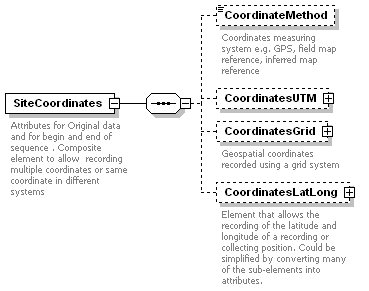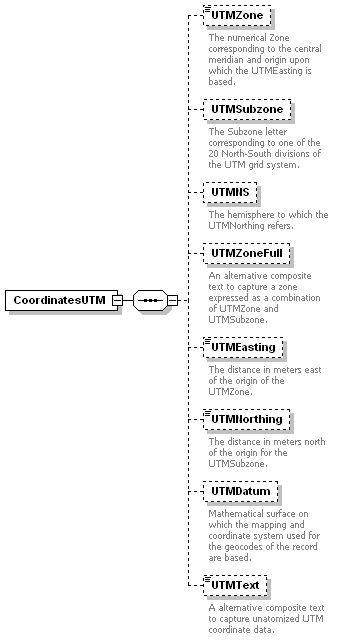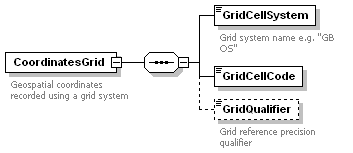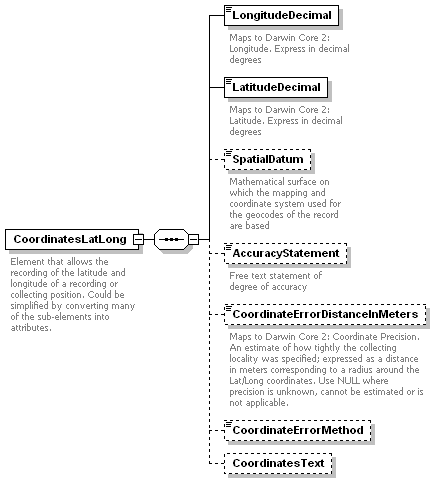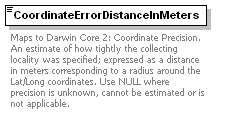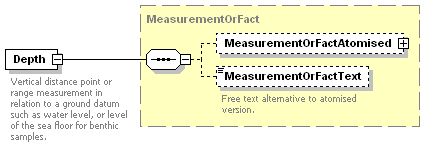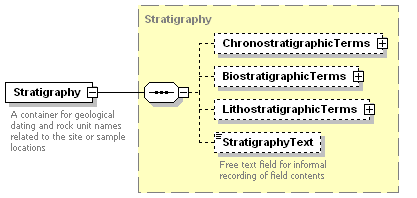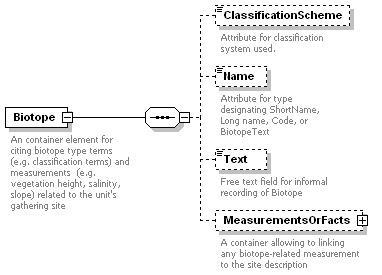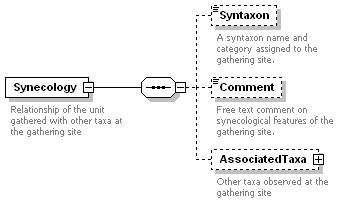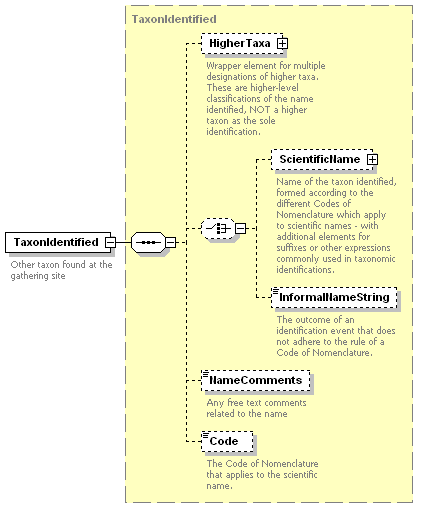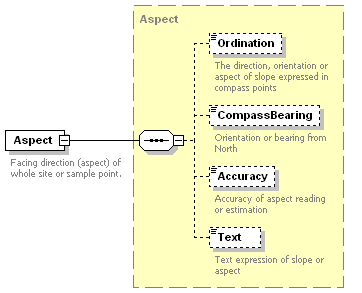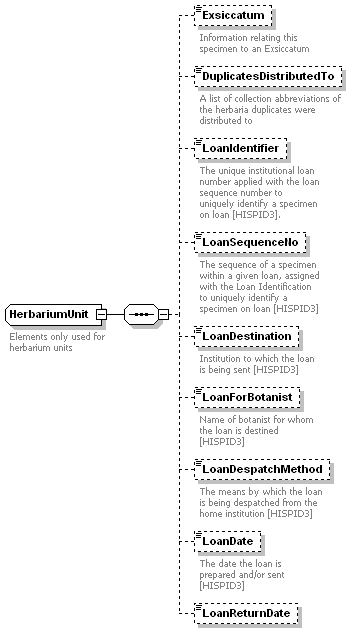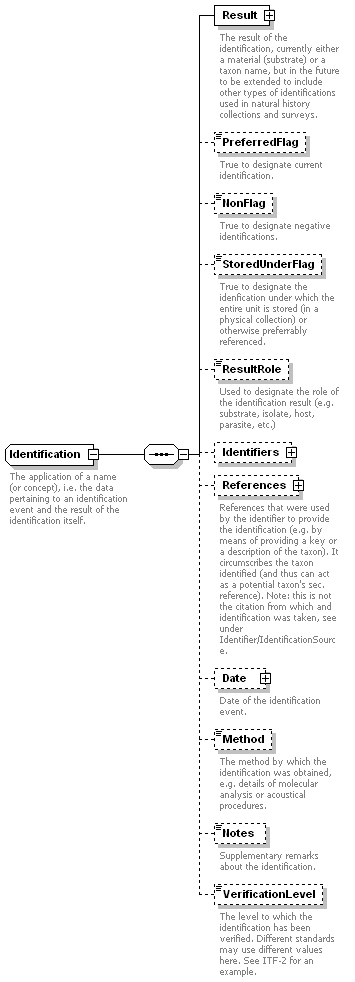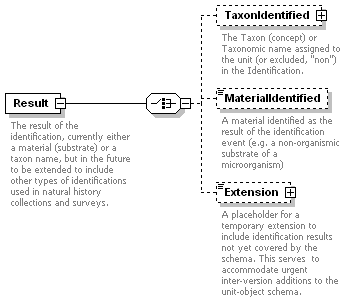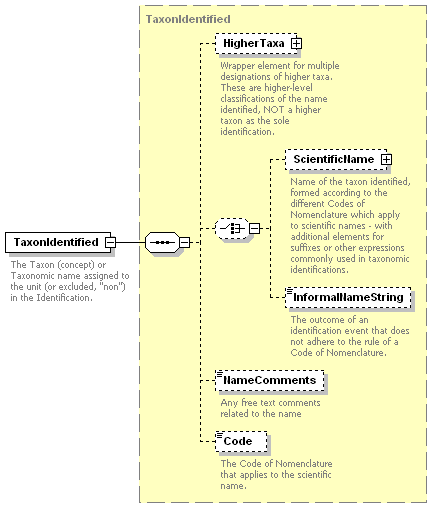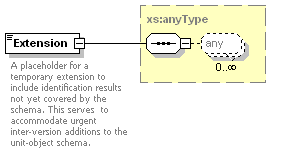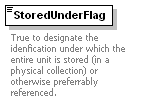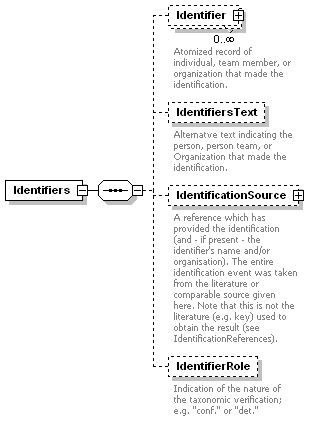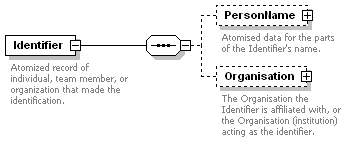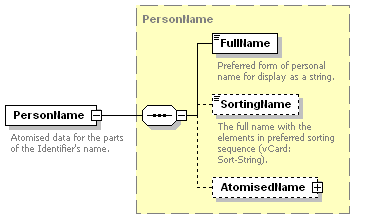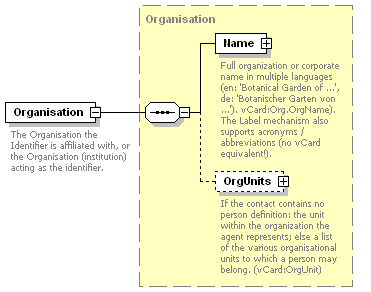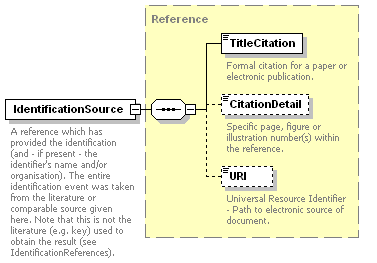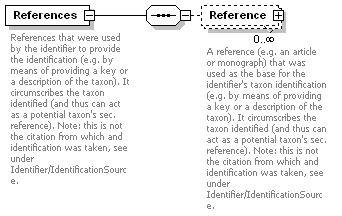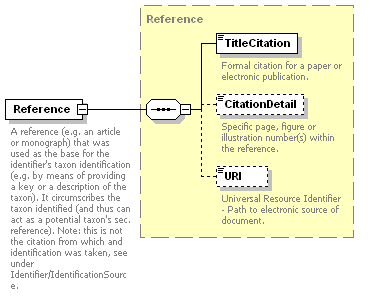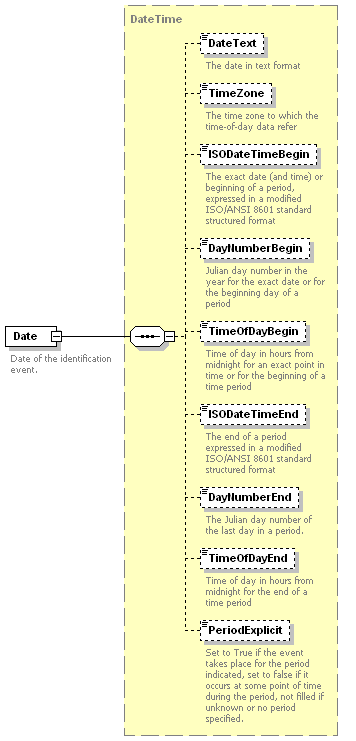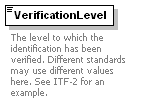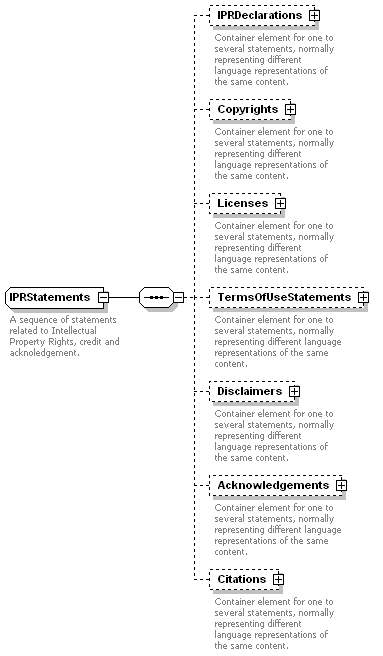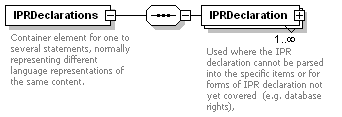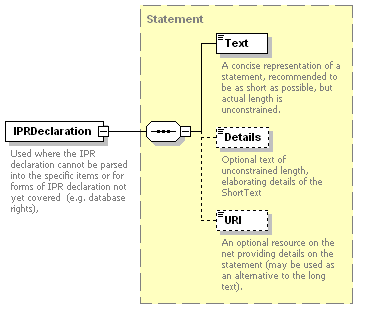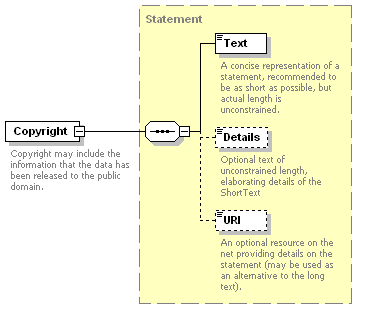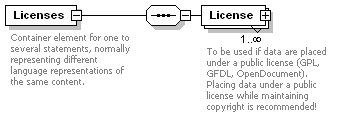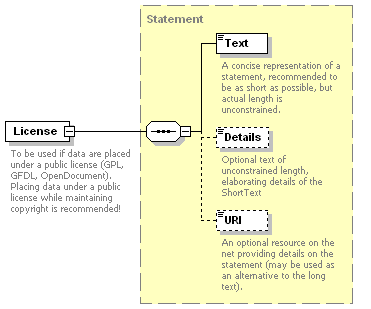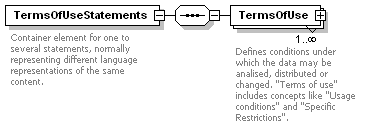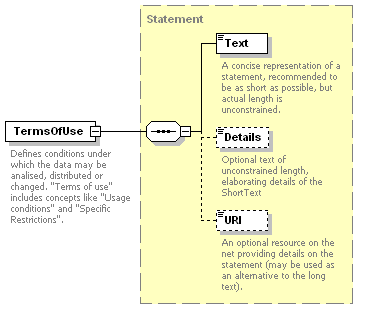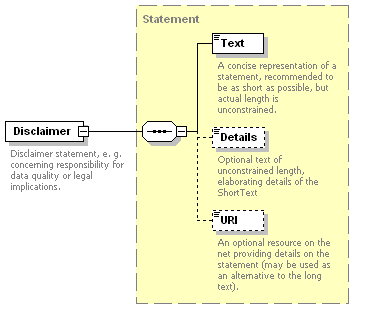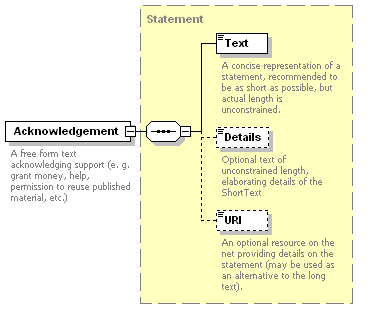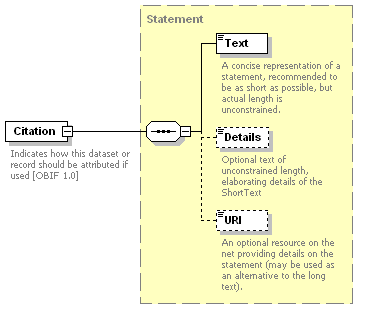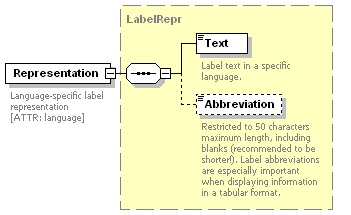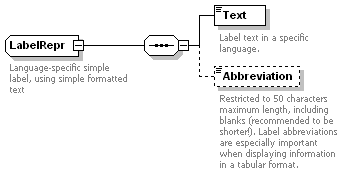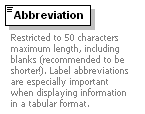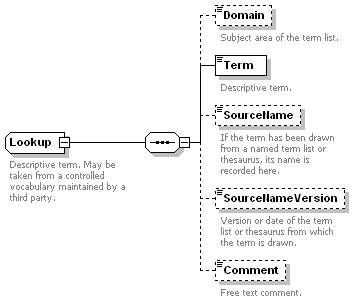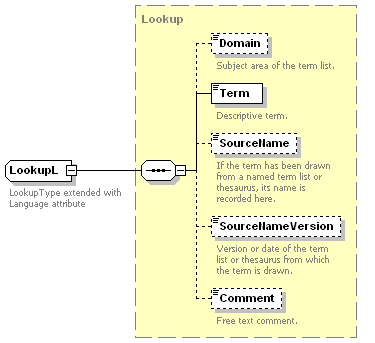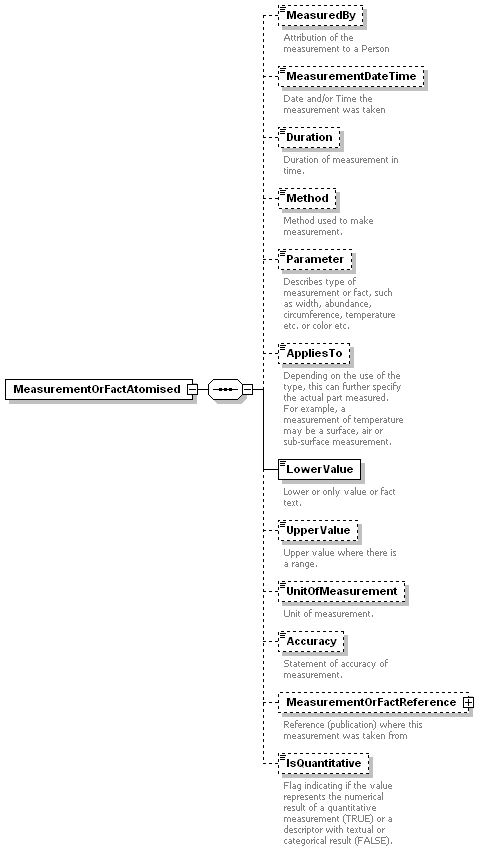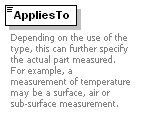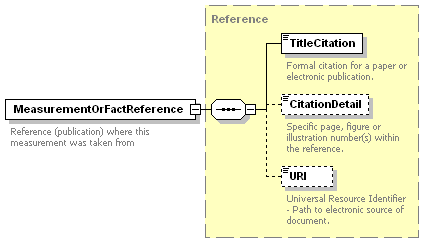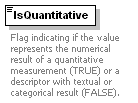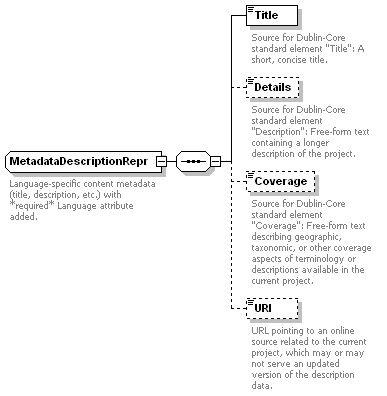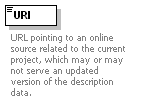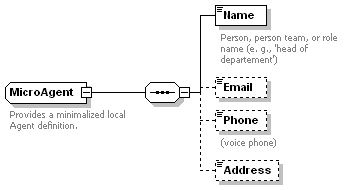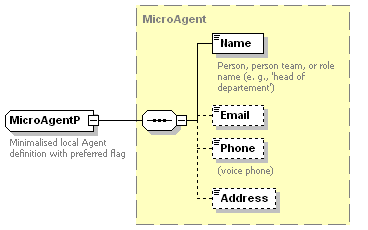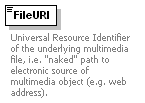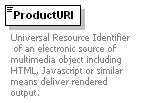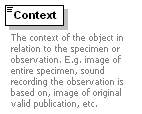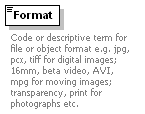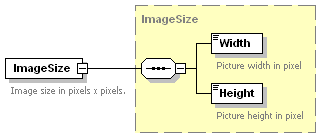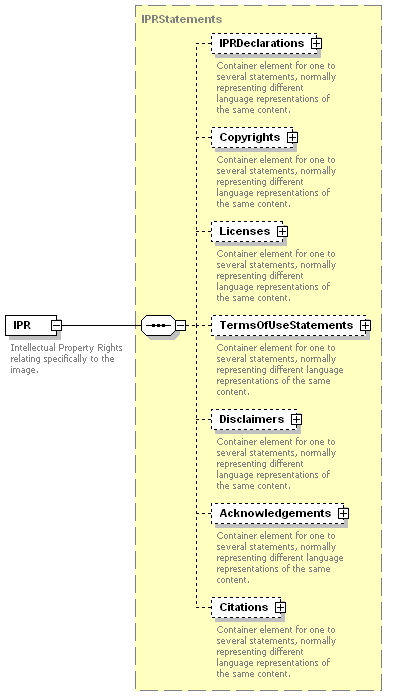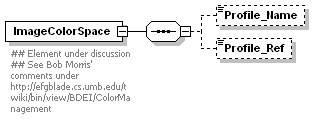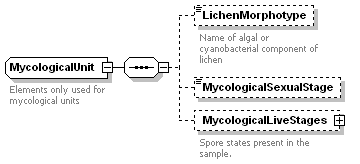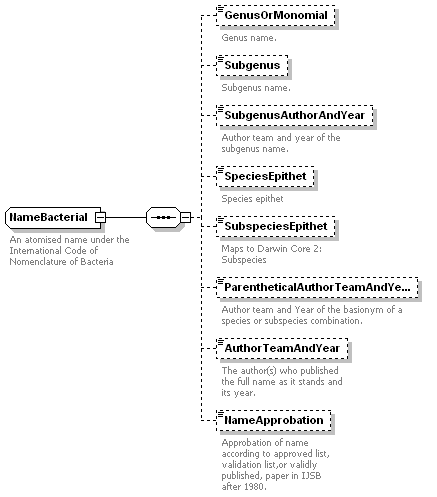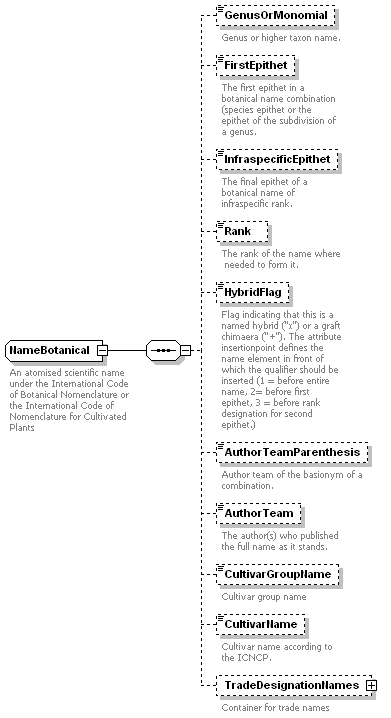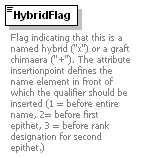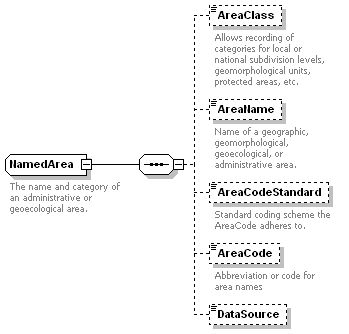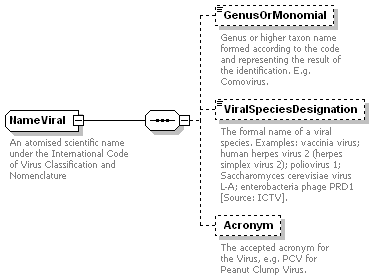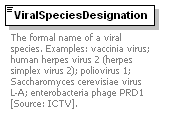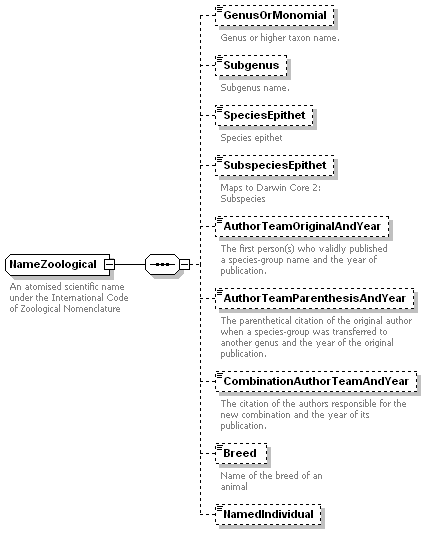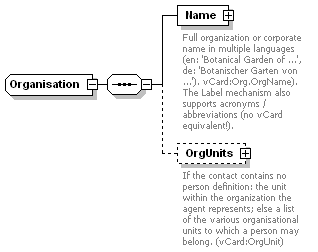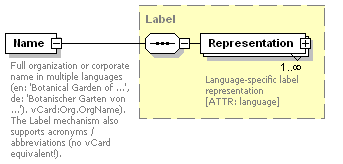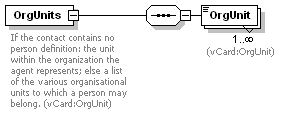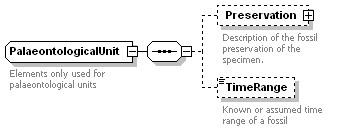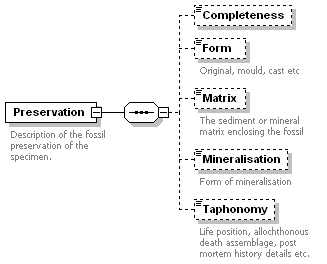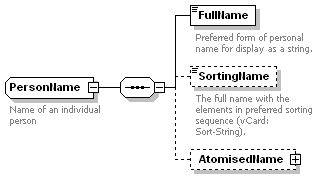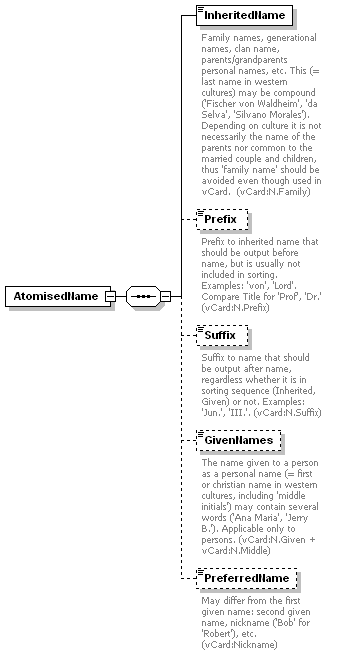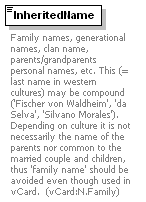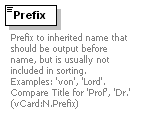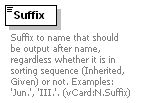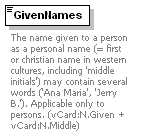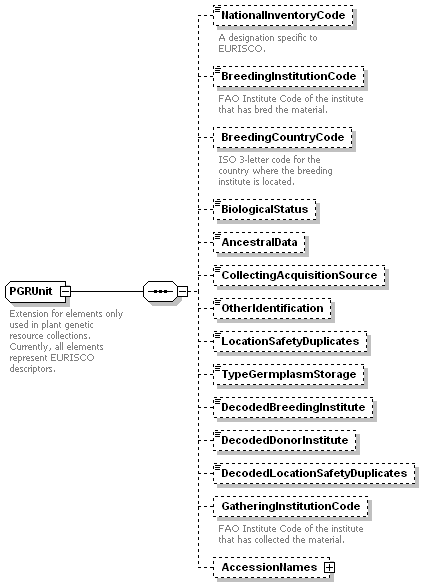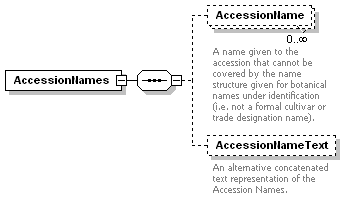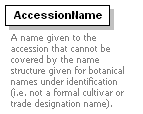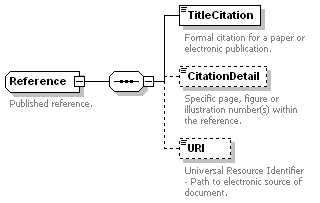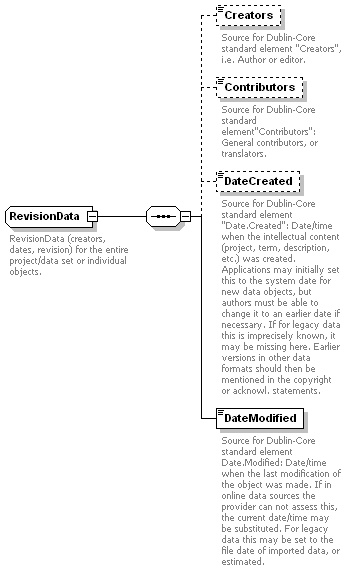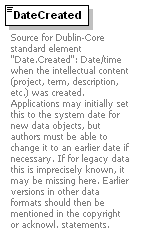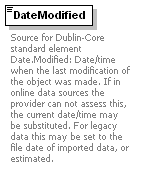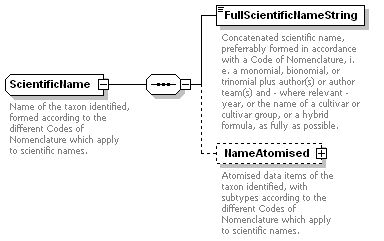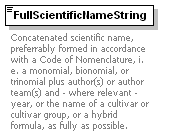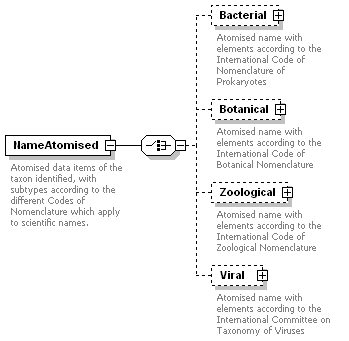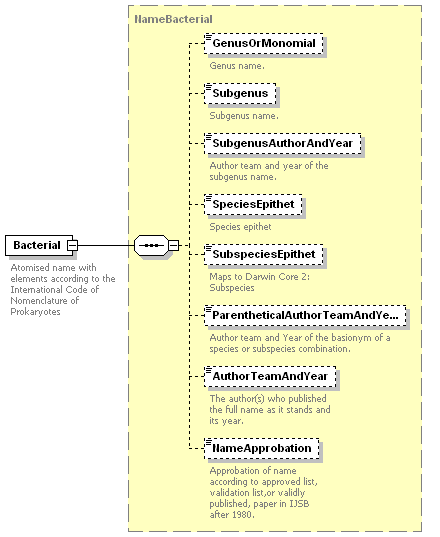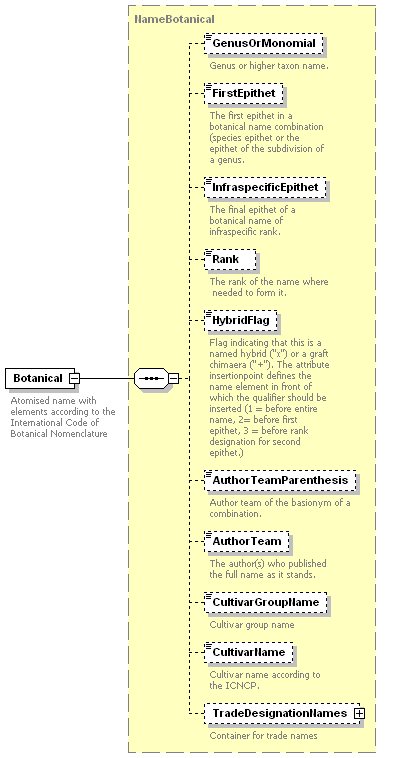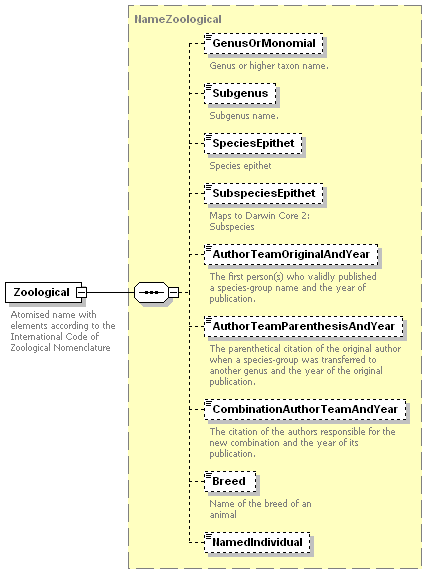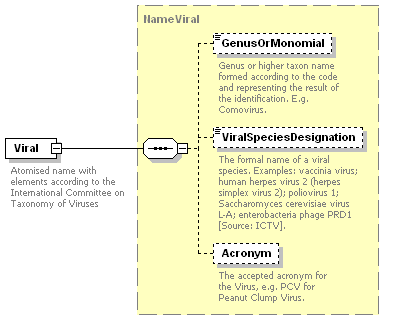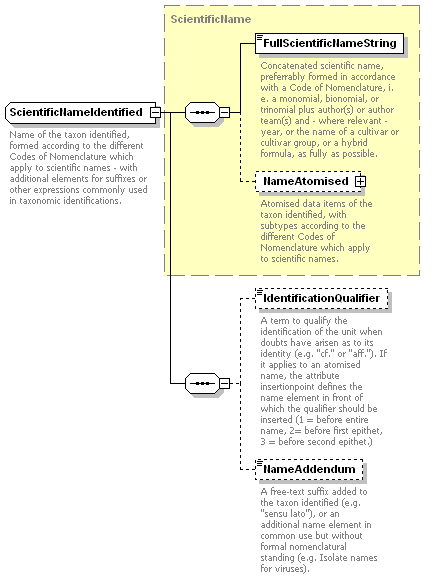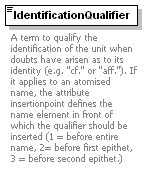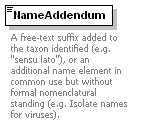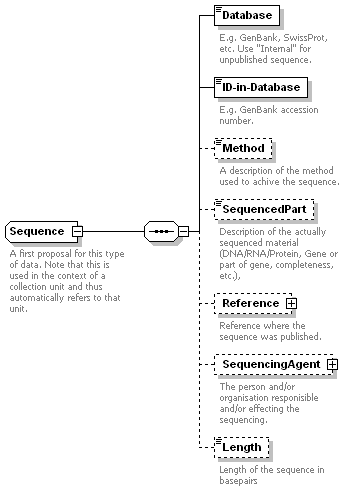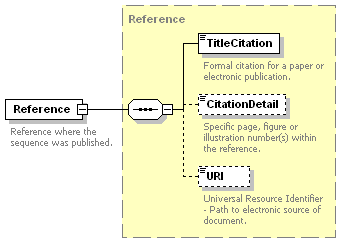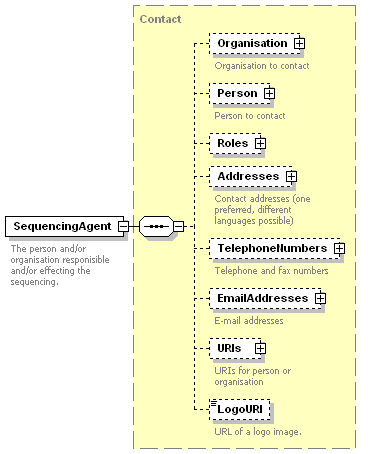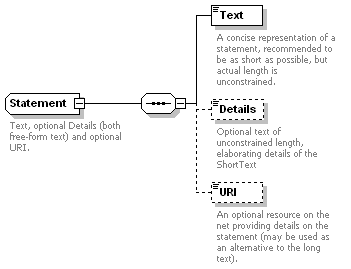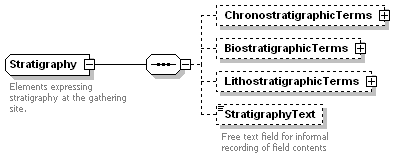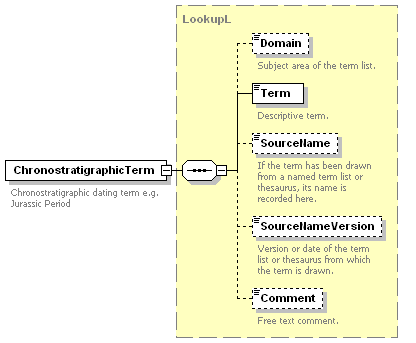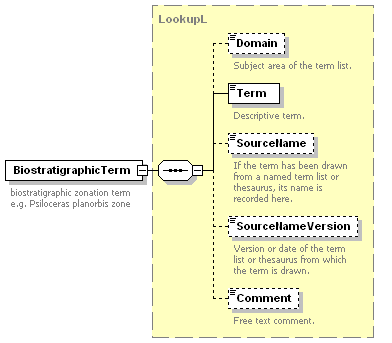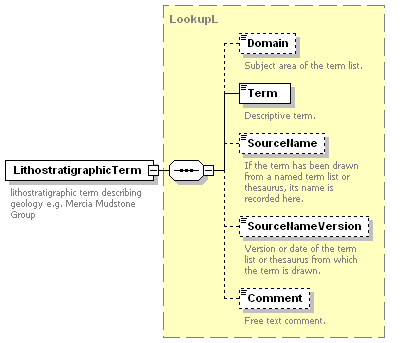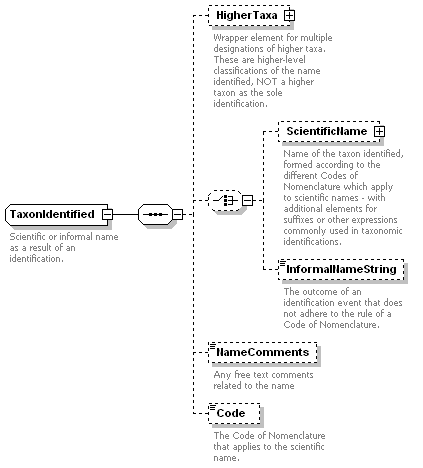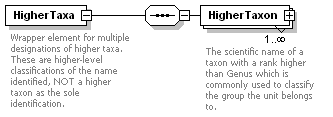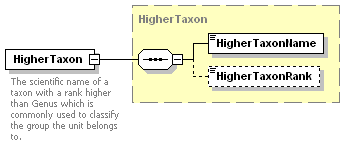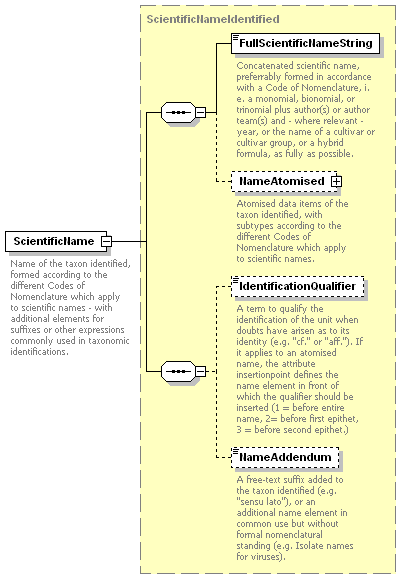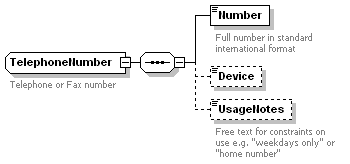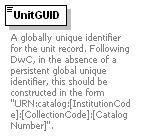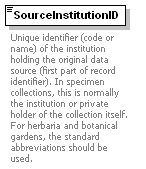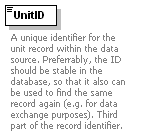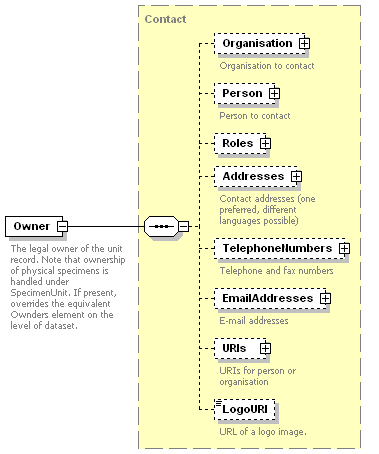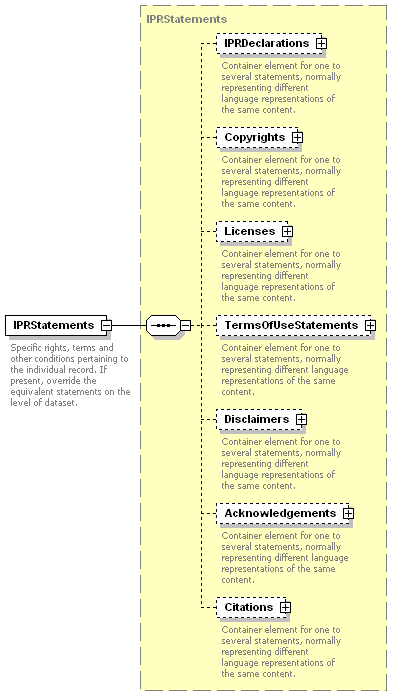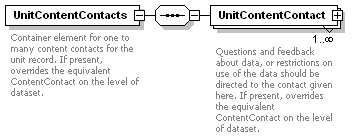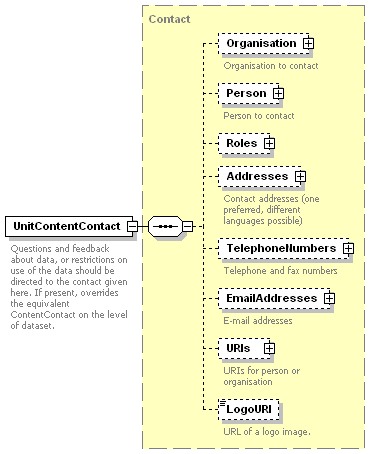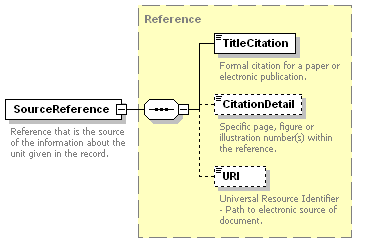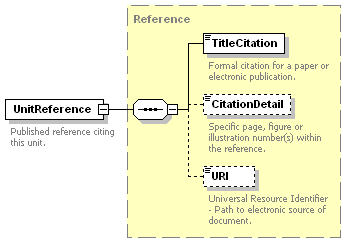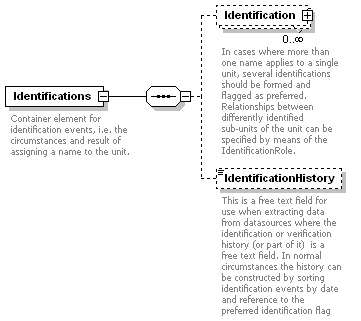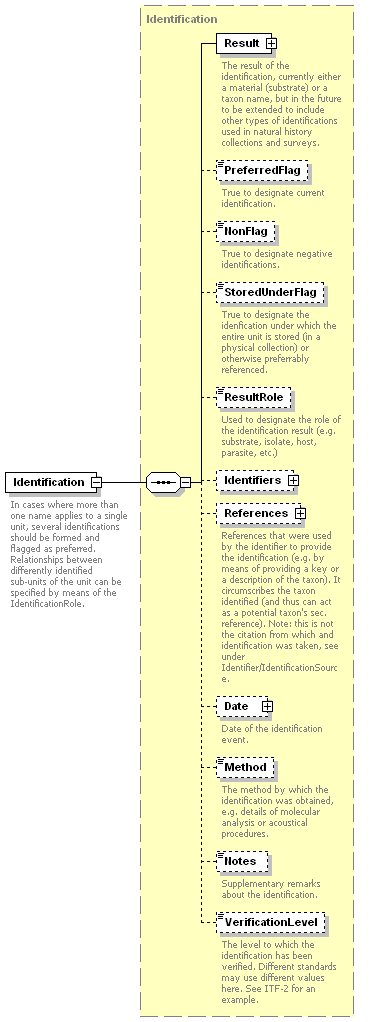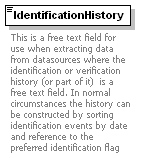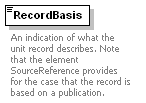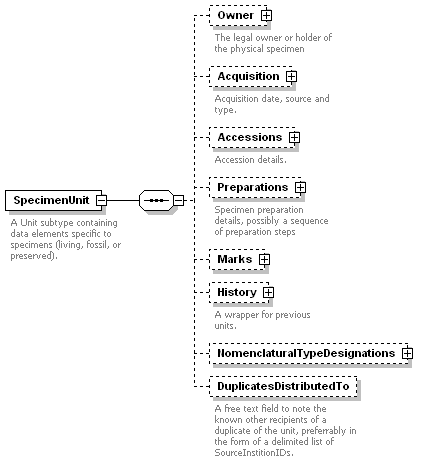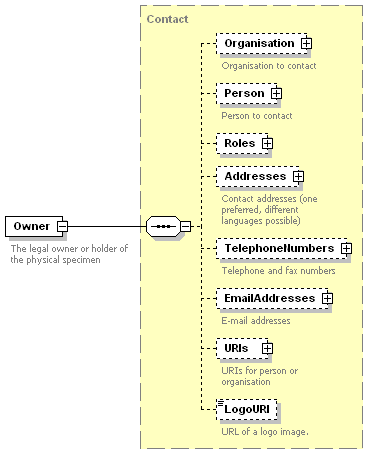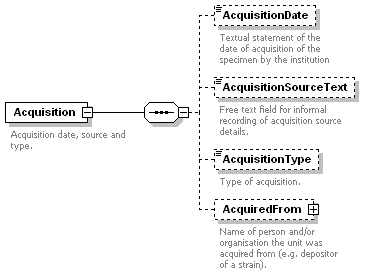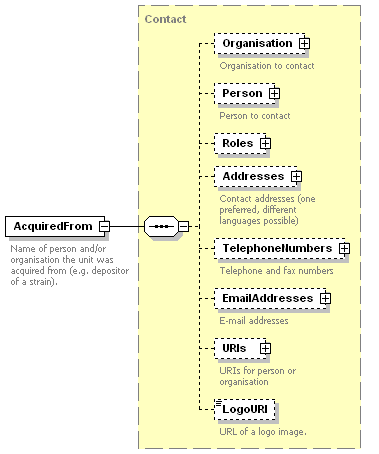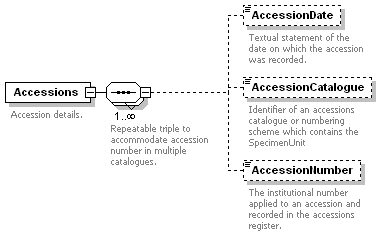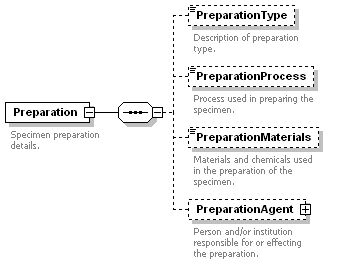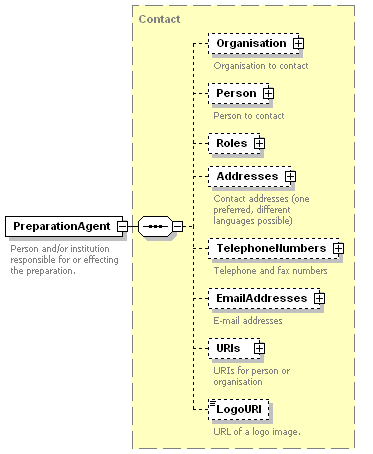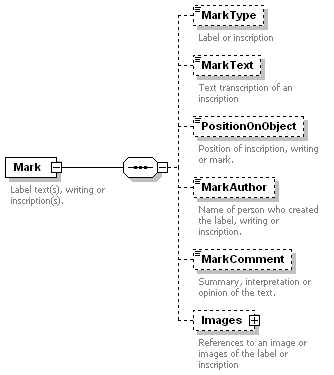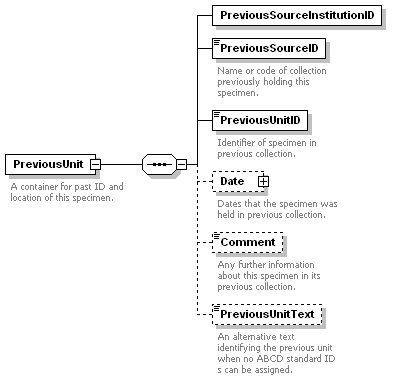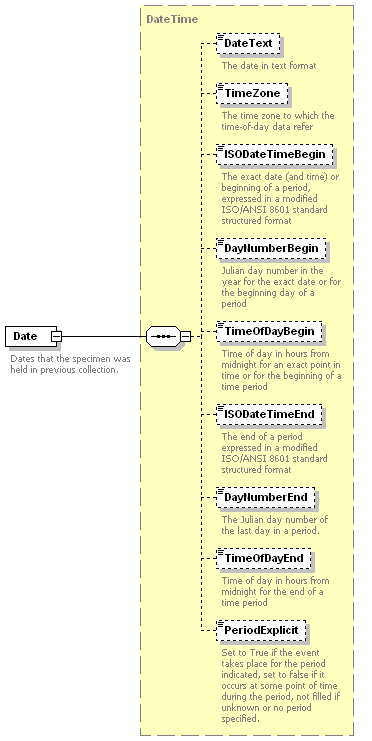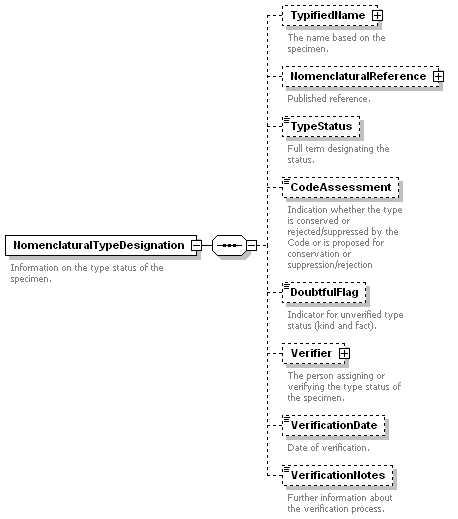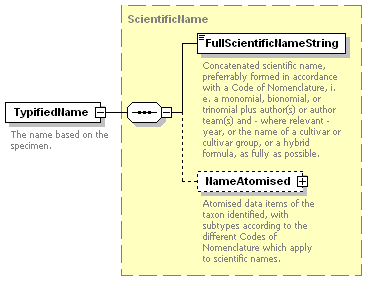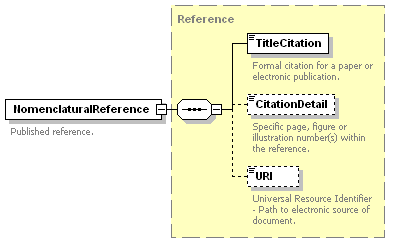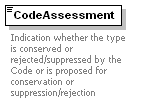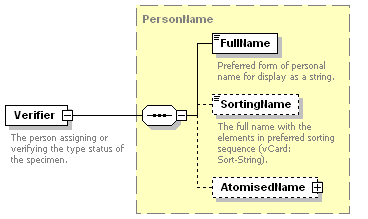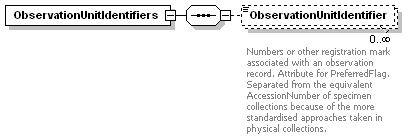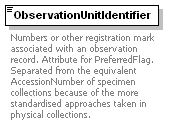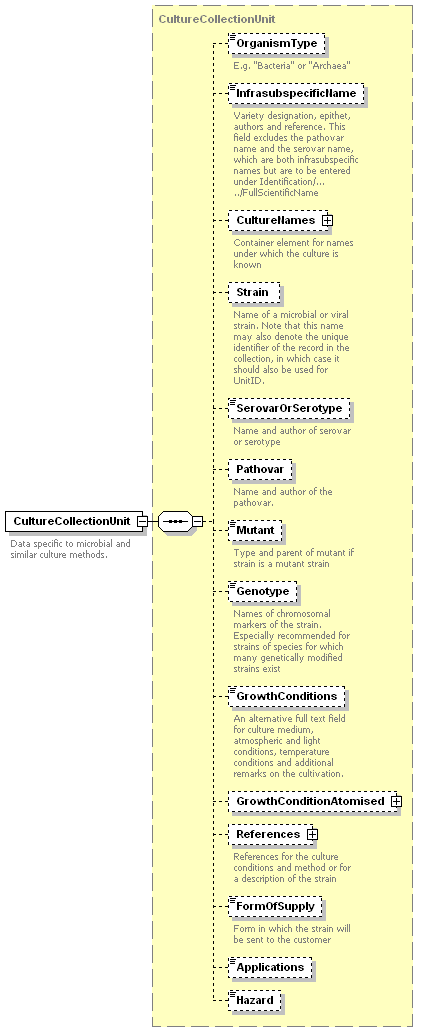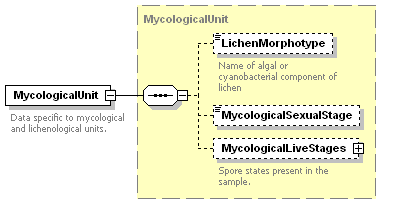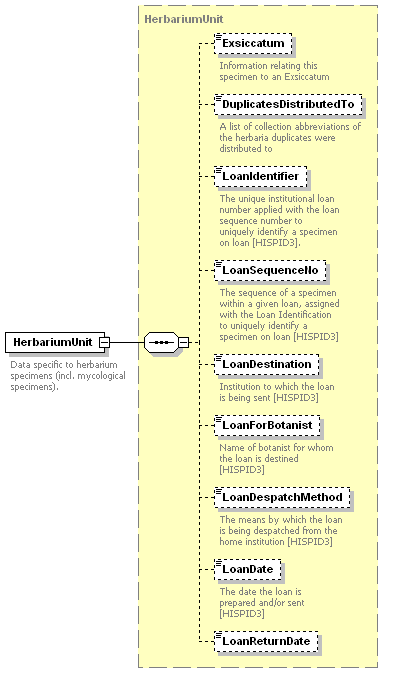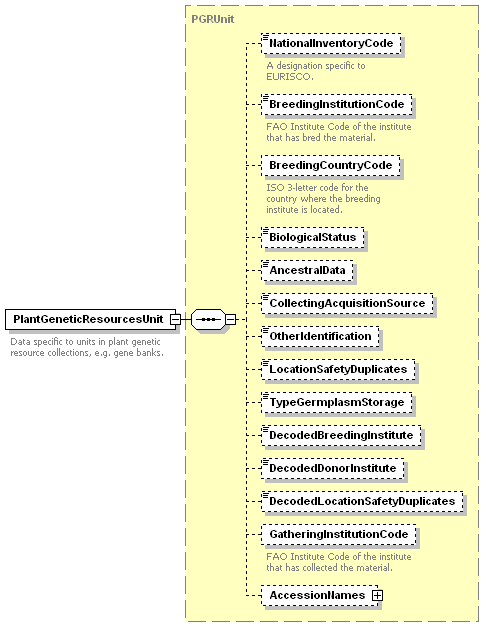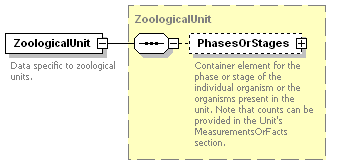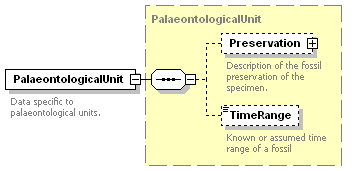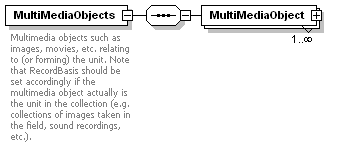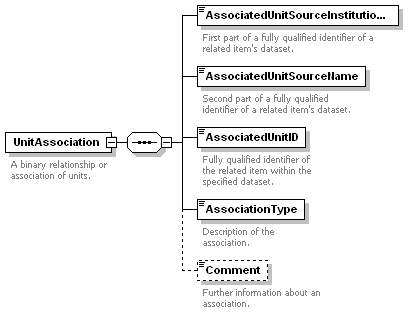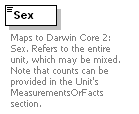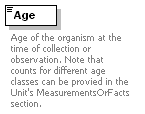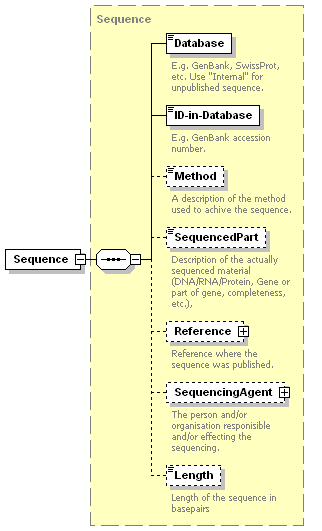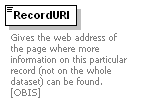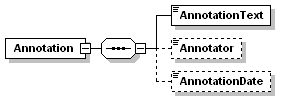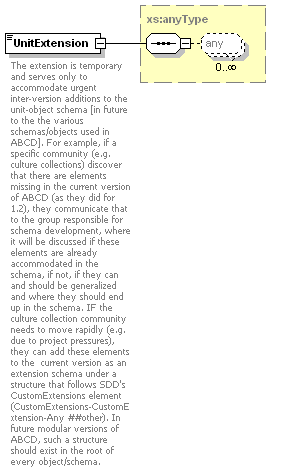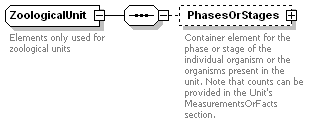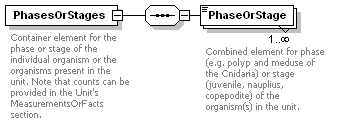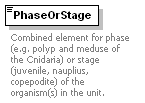| source |
<xs:complexType name="Unit">
<xs:annotation>
<xs:documentation>Elements for all unit-level data</xs:documentation>
</xs:annotation>
<xs:sequence>
<xs:element name="UnitGUID" type="String" minOccurs="0">
<xs:annotation>
<xs:documentation>A globally unique identifier for the unit record. Following DwC, in the absence of a persistent global unique identifier, this should be constructed in the form "URN:catalog:[InstitutionCode]:[CollectionCode]:[CatalogNumber]".</xs:documentation>
</xs:annotation>
</xs:element>
<xs:element name="SourceInstitutionID" type="InstitutionCode">
<xs:annotation>
<xs:documentation>Unique identifier (code or name) of the institution holding the original data source (first part of record identifier). In specimen collections, this is normally the institution or private holder of the collection itself. For herbaria and botanical gardens, the standard abbreviations should be used.</xs:documentation>
</xs:annotation>
</xs:element>
<xs:element name="SourceID" type="String">
<xs:annotation>
<xs:documentation>Name or code of the data source (unique within the institution, second part of the record identifier)</xs:documentation>
</xs:annotation>
</xs:element>
<xs:element name="UnitID" type="String">
<xs:annotation>
<xs:documentation>A unique identifier for the unit record within the data source. Preferrably, the ID should be stable in the database, so that it also can be used to find the same record again (e.g. for data exchange purposes). Third part of the record identifier.</xs:documentation>
</xs:annotation>
</xs:element>
<xs:element name="UnitIDNumeric" type="xs:int" minOccurs="0">
<xs:annotation>
<xs:documentation>Numeric catalogue number. Facilitates soriting of numbers.</xs:documentation>
</xs:annotation>
</xs:element>
<xs:element name="LastEditor" type="String" minOccurs="0">
<xs:annotation>
<xs:documentation>Name or other indication of the person or team that created or last edited this record.</xs:documentation>
</xs:annotation>
</xs:element>
<xs:element name="DateLastEdited" type="xs:dateTime" minOccurs="0">
<xs:annotation>
<xs:documentation>Date of creation or last change of this unit record.</xs:documentation>
</xs:annotation>
</xs:element>
<xs:element name="Owner" type="Contact" minOccurs="0">
<xs:annotation>
<xs:documentation>The legal owner of the unit record. Note that ownership of physical specimens is handled under SpecimenUnit. If present, overrides the equivalent Ownders element on the level of dataset.</xs:documentation>
</xs:annotation>
</xs:element>
<xs:element name="IPRStatements" type="IPRStatements" minOccurs="0">
<xs:annotation>
<xs:documentation>Specific rights, terms and other conditions pertaining to the individual record. If present, override the equivalent statements on the level of dataset.</xs:documentation>
</xs:annotation>
</xs:element>
<xs:element name="UnitContentContacts" minOccurs="0">
<xs:annotation>
<xs:documentation>Container element for one to many content contacts for the unit record. If present, overrides the equivalent ContentContact on the level of dataset.</xs:documentation>
</xs:annotation>
<xs:complexType>
<xs:sequence>
<xs:element name="UnitContentContact" maxOccurs="unbounded">
<xs:annotation>
<xs:documentation>Questions and feedback about data, or restrictions on use of the data should be directed to the contact given here. If present, overrides the equivalent ContentContact on the level of dataset.</xs:documentation>
</xs:annotation>
<xs:complexType>
<xs:complexContent>
<xs:extension base="Contact">
<xs:attribute name="preferred" type="xs:boolean"/>
</xs:extension>
</xs:complexContent>
</xs:complexType>
</xs:element>
</xs:sequence>
</xs:complexType>
</xs:element>
<xs:element name="SourceReference" type="Reference" minOccurs="0">
<xs:annotation>
<xs:documentation>Reference that is the source of the information about the unit given in the record.</xs:documentation>
</xs:annotation>
</xs:element>
<xs:element name="UnitReferences" minOccurs="0">
<xs:annotation>
<xs:documentation>Container element for references citing the unit See SourceReference for the case that the record is based on a publication.</xs:documentation>
</xs:annotation>
<xs:complexType>
<xs:sequence>
<xs:element name="UnitReference" type="Reference" minOccurs="0" maxOccurs="unbounded">
<xs:annotation>
<xs:documentation>Published reference citing this unit.</xs:documentation>
</xs:annotation>
</xs:element>
</xs:sequence>
</xs:complexType>
</xs:element>
<xs:element name="Identifications" minOccurs="0">
<xs:annotation>
<xs:documentation>Container element for identification events, i.e. the circumstances and result of assigning a name to the unit.</xs:documentation>
</xs:annotation>
<xs:complexType>
<xs:sequence>
<xs:element name="Identification" type="Identification" minOccurs="0" maxOccurs="unbounded">
<xs:annotation>
<xs:documentation>In cases where more than one name applies to a single unit, several identifications should be formed and flagged as preferred. Relationships between differently identified sub-units of the unit can be specified by means of the IdentificationRole.</xs:documentation>
</xs:annotation>
</xs:element>
<xs:element name="IdentificationHistory" type="String" minOccurs="0">
<xs:annotation>
<xs:documentation>This is a free text field for use when extracting data from datasources where the identification or verification history (or part of it) is a free text field. In normal circumstances the history can be constructed by sorting identification events by date and reference to the preferred identification flag</xs:documentation>
</xs:annotation>
</xs:element>
</xs:sequence>
</xs:complexType>
</xs:element>
<xs:element name="RecordBasis" type="RecordBasisEnum" minOccurs="0">
<xs:annotation>
<xs:documentation>An indication of what the unit record describes. Note that the element SourceReference provides for the case that the record is based on a publication.</xs:documentation>
</xs:annotation>
</xs:element>
<xs:element name="KindOfUnit" type="StringL" minOccurs="0" maxOccurs="unbounded">
<xs:annotation>
<xs:documentation>Part(s) of organism or class of materials represented by this unit.</xs:documentation>
</xs:annotation>
</xs:element>
<xs:choice>
<xs:annotation>
<xs:documentation>Physical state-specific subtypes of the unit record</xs:documentation>
</xs:annotation>
<xs:element name="SpecimenUnit" minOccurs="0">
<xs:annotation>
<xs:documentation>A Unit subtype containing data elements specific to specimens (living, fossil, or preserved).</xs:documentation>
</xs:annotation>
<xs:complexType>
<xs:sequence>
<xs:element name="Owner" type="Contact" minOccurs="0">
<xs:annotation>
<xs:documentation>The legal owner or holder of the physical specimen</xs:documentation>
</xs:annotation>
</xs:element>
<xs:element name="Acquisition" minOccurs="0">
<xs:annotation>
<xs:documentation>Acquisition date, source and type.</xs:documentation>
</xs:annotation>
<xs:complexType>
<xs:sequence>
<xs:element name="AcquisitionDate" type="String" minOccurs="0">
<xs:annotation>
<xs:documentation>Textual statement of the date of acquisition of the specimen by the institution</xs:documentation>
</xs:annotation>
</xs:element>
<xs:element name="AcquisitionSourceText" type="StringL" minOccurs="0">
<xs:annotation>
<xs:documentation>Free text field for informal recording of acquisition source details.</xs:documentation>
</xs:annotation>
</xs:element>
<xs:element name="AcquisitionType" type="StringL" minOccurs="0">
<xs:annotation>
<xs:documentation>Type of acquisition.</xs:documentation>
</xs:annotation>
</xs:element>
<xs:element name="AcquiredFrom" type="Contact" minOccurs="0">
<xs:annotation>
<xs:documentation>Name of person and/or organisation the unit was acquired from (e.g. depositor of a strain).</xs:documentation>
</xs:annotation>
</xs:element>
</xs:sequence>
</xs:complexType>
</xs:element>
<xs:element name="Accessions" minOccurs="0">
<xs:annotation>
<xs:documentation>Accession details.</xs:documentation>
</xs:annotation>
<xs:complexType>
<xs:sequence maxOccurs="unbounded">
<xs:annotation>
<xs:documentation>Repeatable triple to accommodate accession number in multiple catalogues.</xs:documentation>
</xs:annotation>
<xs:element name="AccessionDate" type="String" minOccurs="0">
<xs:annotation>
<xs:documentation>Textual statement of the date on which the accession was recorded.</xs:documentation>
</xs:annotation>
</xs:element>
<xs:element name="AccessionCatalogue" type="String" minOccurs="0">
<xs:annotation>
<xs:documentation>Identifier of an accessions catalogue or numbering scheme which contains the SpecimenUnit</xs:documentation>
</xs:annotation>
</xs:element>
<xs:element name="AccessionNumber" type="String" minOccurs="0">
<xs:annotation>
<xs:documentation>The institutional number applied to an accession and recorded in the accessions register.</xs:documentation>
</xs:annotation>
</xs:element>
</xs:sequence>
</xs:complexType>
</xs:element>
<xs:element name="Preparations" minOccurs="0">
<xs:annotation>
<xs:documentation>Specimen preparation details, possibly a sequence of preparation steps</xs:documentation>
</xs:annotation>
<xs:complexType>
<xs:sequence>
<xs:element name="Preparation" maxOccurs="unbounded">
<xs:annotation>
<xs:documentation>Specimen preparation details.</xs:documentation>
</xs:annotation>
<xs:complexType>
<xs:sequence>
<xs:element name="PreparationType" type="StringL" minOccurs="0">
<xs:annotation>
<xs:documentation>Description of preparation type.</xs:documentation>
</xs:annotation>
</xs:element>
<xs:element name="PreparationProcess" type="StringL" minOccurs="0">
<xs:annotation>
<xs:documentation>Process used in preparing the specimen.</xs:documentation>
</xs:annotation>
</xs:element>
<xs:element name="PreparationMaterials" type="StringL" minOccurs="0">
<xs:annotation>
<xs:documentation>Materials and chemicals used in the preparation of the specimen.</xs:documentation>
</xs:annotation>
</xs:element>
<xs:element name="PreparationAgent" type="Contact" minOccurs="0">
<xs:annotation>
<xs:documentation>Person and/or institution responsible for or effecting the preparation.</xs:documentation>
</xs:annotation>
</xs:element>
</xs:sequence>
<xs:attribute name="sequence" type="xs:int" use="optional"/>
</xs:complexType>
</xs:element>
</xs:sequence>
</xs:complexType>
</xs:element>
<xs:element name="Marks" minOccurs="0">
<xs:complexType>
<xs:sequence>
<xs:element name="Mark" maxOccurs="unbounded">
<xs:annotation>
<xs:documentation>Label text(s), writing or inscription(s).</xs:documentation>
</xs:annotation>
<xs:complexType>
<xs:sequence>
<xs:element name="MarkType" type="StringL" minOccurs="0">
<xs:annotation>
<xs:documentation>Label or inscription</xs:documentation>
<xs:documentation>
<sea:FullName/>
<sea:Reviewer/>
</xs:documentation>
</xs:annotation>
</xs:element>
<xs:element name="MarkText" type="StringL" minOccurs="0">
<xs:annotation>
<xs:documentation>Text transcription of an inscription</xs:documentation>
</xs:annotation>
</xs:element>
<xs:element name="PositionOnObject" type="StringL" minOccurs="0">
<xs:annotation>
<xs:documentation>Position of inscription, writing or mark.</xs:documentation>
</xs:annotation>
</xs:element>
<xs:element name="MarkAuthor" type="String" minOccurs="0">
<xs:annotation>
<xs:documentation>Name of person who created the label, writing or inscription.</xs:documentation>
</xs:annotation>
</xs:element>
<xs:element name="MarkComment" type="StringL" minOccurs="0">
<xs:annotation>
<xs:documentation>Summary, interpretation or opinion of the text.</xs:documentation>
</xs:annotation>
</xs:element>
<xs:element name="Images" minOccurs="0">
<xs:annotation>
<xs:documentation>References to an image or images of the label or inscription</xs:documentation>
</xs:annotation>
<xs:complexType>
<xs:sequence>
<xs:element name="ImageID" type="String">
<xs:annotation>
<xs:documentation>The ID of a multimedia object representing the image of the mark</xs:documentation>
</xs:annotation>
</xs:element>
</xs:sequence>
</xs:complexType>
</xs:element>
</xs:sequence>
</xs:complexType>
</xs:element>
</xs:sequence>
</xs:complexType>
</xs:element>
<xs:element name="History" minOccurs="0">
<xs:annotation>
<xs:documentation>A wrapper for previous units.</xs:documentation>
</xs:annotation>
<xs:complexType>
<xs:sequence>
<xs:element name="PreviousUnits" minOccurs="0">
<xs:complexType>
<xs:sequence>
<xs:element name="PreviousUnit" maxOccurs="unbounded">
<xs:annotation>
<xs:documentation>A container for past ID and location of this specimen.</xs:documentation>
</xs:annotation>
<xs:complexType>
<xs:sequence>
<xs:element name="PreviousSourceInstitutionID"/>
<xs:element name="PreviousSourceID" type="String">
<xs:annotation>
<xs:documentation>Name or code of collection previously holding this specimen.</xs:documentation>
</xs:annotation>
</xs:element>
<xs:element name="PreviousUnitID" type="String">
<xs:annotation>
<xs:documentation>Identifier of specimen in previous collection.</xs:documentation>
</xs:annotation>
</xs:element>
<xs:element name="Date" type="DateTime" minOccurs="0">
<xs:annotation>
<xs:documentation>Dates that the specimen was held in previous collection.</xs:documentation>
</xs:annotation>
</xs:element>
<xs:element name="Comment" type="StringL" minOccurs="0">
<xs:annotation>
<xs:documentation>Any further information about this specimen in its previous collection.</xs:documentation>
</xs:annotation>
</xs:element>
<xs:element name="PreviousUnitText" type="StringL" minOccurs="0">
<xs:annotation>
<xs:documentation>An alternative text identifying the previous unit when no ABCD standard ID s can be assigned.</xs:documentation>
</xs:annotation>
</xs:element>
</xs:sequence>
<xs:attribute name="sequence" type="xs:int" use="optional"/>
</xs:complexType>
</xs:element>
</xs:sequence>
</xs:complexType>
</xs:element>
<xs:element name="PreviousUnitsText" minOccurs="0"/>
</xs:sequence>
</xs:complexType>
</xs:element>
<xs:element name="NomenclaturalTypeDesignations" minOccurs="0">
<xs:complexType>
<xs:sequence>
<xs:element name="NomenclaturalTypeDesignation" minOccurs="0" maxOccurs="unbounded">
<xs:annotation>
<xs:documentation>Information on the type status of the specimen.</xs:documentation>
</xs:annotation>
<xs:complexType>
<xs:sequence>
<xs:element name="TypifiedName" type="ScientificName" minOccurs="0">
<xs:annotation>
<xs:documentation>The name based on the specimen.</xs:documentation>
</xs:annotation>
</xs:element>
<xs:element name="NomenclaturalReference" type="Reference" minOccurs="0">
<xs:annotation>
<xs:documentation>Published reference.</xs:documentation>
</xs:annotation>
</xs:element>
<xs:element name="TypeStatus" type="String" minOccurs="0">
<xs:annotation>
<xs:documentation>Full term designating the status.</xs:documentation>
</xs:annotation>
</xs:element>
<xs:element name="CodeAssessment" type="String" minOccurs="0">
<xs:annotation>
<xs:documentation>Indication whether the type is conserved or rejected/suppressed by the Code or is proposed for conservation or suppression/rejection</xs:documentation>
</xs:annotation>
</xs:element>
<xs:element name="DoubtfulFlag" type="String" minOccurs="0">
<xs:annotation>
<xs:documentation>Indicator for unverified type status (kind and fact).</xs:documentation>
</xs:annotation>
</xs:element>
<xs:element name="Verifier" type="PersonName" minOccurs="0">
<xs:annotation>
<xs:documentation>The person assigning or verifying the type status of the specimen.</xs:documentation>
</xs:annotation>
</xs:element>
<xs:element name="VerificationDate" type="xs:date" minOccurs="0">
<xs:annotation>
<xs:documentation>Date of verification.</xs:documentation>
</xs:annotation>
</xs:element>
<xs:element name="VerificationNotes" type="StringL" minOccurs="0">
<xs:annotation>
<xs:documentation>Further information about the verification process.</xs:documentation>
</xs:annotation>
</xs:element>
</xs:sequence>
</xs:complexType>
</xs:element>
</xs:sequence>
</xs:complexType>
</xs:element>
<xs:element name="DuplicatesDistributedTo" minOccurs="0">
<xs:annotation>
<xs:documentation>A free text field to note the known other recipients of a duplicate of the unit, preferrably in the form of a delimited list of SourceInstitionIDs.</xs:documentation>
</xs:annotation>
</xs:element>
</xs:sequence>
</xs:complexType>
</xs:element>
<xs:element name="ObservationUnit" minOccurs="0">
<xs:annotation>
<xs:documentation>Data elements specific to observation (recording) units. Note that most observation data items are site related and thus covered under Gathering.</xs:documentation>
</xs:annotation>
<xs:complexType>
<xs:sequence>
<xs:element name="ObservationUnitIdentifiers" minOccurs="0">
<xs:complexType>
<xs:sequence>
<xs:element name="ObservationUnitIdentifier" type="StringP" minOccurs="0" maxOccurs="unbounded">
<xs:annotation>
<xs:documentation>Numbers or other registration mark associated with an observation record. Attribute for PreferredFlag. Separated from the equivalent AccessionNumber of specimen collections because of the more standardised approaches taken in physical collections.</xs:documentation>
</xs:annotation>
</xs:element>
</xs:sequence>
</xs:complexType>
</xs:element>
</xs:sequence>
</xs:complexType>
</xs:element>
</xs:choice>
<xs:sequence>
<xs:annotation>
<xs:documentation>Collection type and/or taxonomic domain-specific schema extensions (subtypes of the unit record).</xs:documentation>
</xs:annotation>
<xs:element name="CultureCollectionUnit" type="CultureCollectionUnit" minOccurs="0">
<xs:annotation>
<xs:documentation>Data specific to microbial and similar culture methods.</xs:documentation>
</xs:annotation>
</xs:element>
<xs:element name="MycologicalUnit" type="MycologicalUnit" minOccurs="0">
<xs:annotation>
<xs:documentation>Data specific to mycological and lichenological units.</xs:documentation>
</xs:annotation>
</xs:element>
<xs:element name="HerbariumUnit" type="HerbariumUnit" minOccurs="0">
<xs:annotation>
<xs:documentation>Data specific to herbarium specimens (incl. mycological specimens).</xs:documentation>
</xs:annotation>
</xs:element>
<xs:element name="BotanicalGardenUnit" type="BotanicalGardenUnit" minOccurs="0">
<xs:annotation>
<xs:documentation>Data specific to units in botanical live (horticultural) collections.</xs:documentation>
</xs:annotation>
</xs:element>
<xs:element name="PlantGeneticResourcesUnit" type="PGRUnit" minOccurs="0">
<xs:annotation>
<xs:documentation>Data specific to units in plant genetic resource collections, e.g. gene banks.</xs:documentation>
</xs:annotation>
</xs:element>
<xs:element name="ZoologicalUnit" type="ZoologicalUnit" minOccurs="0">
<xs:annotation>
<xs:documentation>Data specific to zoological units.</xs:documentation>
</xs:annotation>
</xs:element>
<xs:element name="PalaeontologicalUnit" type="PalaeontologicalUnit" minOccurs="0">
<xs:annotation>
<xs:documentation>Data specific to palaeontological units.</xs:documentation>
</xs:annotation>
</xs:element>
</xs:sequence>
<xs:element name="MultiMediaObjects" minOccurs="0">
<xs:annotation>
<xs:documentation>Multimedia objects such as images, movies, etc. relating to (or forming) the unit. Note that RecordBasis should be set accordingly if the multimedia object actually is the unit in the collection (e.g. collections of images taken in the field, sound recordings, etc.).</xs:documentation>
</xs:annotation>
<xs:complexType>
<xs:sequence>
<xs:element name="MultiMediaObject" type="MultiMediaObject" maxOccurs="unbounded"/>
</xs:sequence>
</xs:complexType>
</xs:element>
<xs:element name="Associations" minOccurs="0">
<xs:annotation>
<xs:documentation>Relationships of this unit record with other unit records in ABCD conformant datasets.</xs:documentation>
</xs:annotation>
<xs:complexType>
<xs:sequence>
<xs:element name="UnitAssociation" maxOccurs="unbounded">
<xs:annotation>
<xs:documentation>A binary relationship or association of units.</xs:documentation>
</xs:annotation>
<xs:complexType>
<xs:sequence>
<xs:element name="AssociatedUnitSourceInstitutionCode" type="String">
<xs:annotation>
<xs:documentation>First part of a fully qualified identifier of a related item's dataset.</xs:documentation>
</xs:annotation>
</xs:element>
<xs:element name="AssociatedUnitSourceName" type="String">
<xs:annotation>
<xs:documentation>Second part of a fully qualified identifier of a related item's dataset.</xs:documentation>
</xs:annotation>
</xs:element>
<xs:element name="AssociatedUnitID" type="String">
<xs:annotation>
<xs:documentation>Fully qualified identifier of the related item within the specified dataset.</xs:documentation>
</xs:annotation>
</xs:element>
<xs:element name="AssociationType" type="StringL">
<xs:annotation>
<xs:documentation>Description of the association.</xs:documentation>
</xs:annotation>
</xs:element>
<xs:element name="Comment" type="StringL" minOccurs="0">
<xs:annotation>
<xs:documentation>Further information about an association.</xs:documentation>
</xs:annotation>
</xs:element>
</xs:sequence>
</xs:complexType>
</xs:element>
</xs:sequence>
</xs:complexType>
</xs:element>
<xs:element name="Assemblages" minOccurs="0">
<xs:annotation>
<xs:documentation>A container for groupings of this unit record with other unit records in this dataset by means of an additional ID.</xs:documentation>
</xs:annotation>
<xs:complexType>
<xs:sequence>
<xs:element name="UnitAssemblage" maxOccurs="unbounded">
<xs:annotation>
<xs:documentation>A unit assemblage handles symmetric relationships between several units.</xs:documentation>
</xs:annotation>
<xs:complexType>
<xs:sequence>
<xs:element name="AssemblageID" type="String">
<xs:annotation>
<xs:documentation>Identifier for assemblage.</xs:documentation>
</xs:annotation>
</xs:element>
<xs:element name="AssemblageName" type="StringL" minOccurs="0">
<xs:annotation>
<xs:documentation>Name of assemblage.</xs:documentation>
</xs:annotation>
</xs:element>
</xs:sequence>
</xs:complexType>
</xs:element>
</xs:sequence>
</xs:complexType>
</xs:element>
<xs:element name="NamedCollectionsOrSurveys" minOccurs="0">
<xs:annotation>
<xs:documentation>Unit may belong to one or several collections or survey projects which have distinctive names and do not correspond to the SourceName. Note that this element refers to the name accepted by the specimen or data holding institution, this may or may not be different from the project name given under Gathering.</xs:documentation>
</xs:annotation>
<xs:complexType>
<xs:sequence>
<xs:element name="NamedCollectionOrSurvey" type="StringL" maxOccurs="unbounded"/>
</xs:sequence>
</xs:complexType>
</xs:element>
<xs:element name="Gathering" type="Gathering" minOccurs="0">
<xs:annotation>
<xs:documentation>Elements describing the field events that created the unit and their location.</xs:documentation>
</xs:annotation>
</xs:element>
<xs:element name="CollectorsFieldNumber" type="String" minOccurs="0">
<xs:annotation>
<xs:documentation>A number assigned to the unit by the collector or observer. Note that the respective collector's name is found under gathering (GatheringAgents).</xs:documentation>
</xs:annotation>
</xs:element>
<xs:element name="MeasurementsOrFacts" minOccurs="0">
<xs:annotation>
<xs:documentation>A container for quantitative and categorical measurements (including observations) refering to the unit, e.g. counts, size measurements, colours, etc.</xs:documentation>
</xs:annotation>
<xs:complexType>
<xs:sequence>
<xs:element name="MeasurementOrFact" type="MeasurementOrFact" minOccurs="0" maxOccurs="unbounded">
<xs:annotation>
<xs:documentation>Quantitative or categorical measurement refering to the unit.</xs:documentation>
</xs:annotation>
</xs:element>
</xs:sequence>
</xs:complexType>
</xs:element>
<xs:element name="Sex" type="SexCodeEnum" minOccurs="0">
<xs:annotation>
<xs:documentation>Maps to Darwin Core 2: Sex. Refers to the entire unit, which may be mixed. Note that counts can be provided in the Unit's MeasurementsOrFacts section.</xs:documentation>
</xs:annotation>
</xs:element>
<xs:element name="Age" type="String" minOccurs="0">
<xs:annotation>
<xs:documentation>Age of the organism at the time of collection or observation. Note that counts for different age classes can be provied in the Unit's MeasurementsOrFacts section.</xs:documentation>
</xs:annotation>
</xs:element>
<xs:element name="Sequences" minOccurs="0">
<xs:annotation>
<xs:documentation>Container for medata on sequences derived from this unit.</xs:documentation>
</xs:annotation>
<xs:complexType>
<xs:sequence>
<xs:element name="Sequence" type="Sequence" maxOccurs="unbounded"/>
</xs:sequence>
</xs:complexType>
</xs:element>
<xs:element name="Notes" type="StringL" minOccurs="0">
<xs:annotation>
<xs:documentation>Miscellaneous notes referring to the unit that do not fit elsewhere.</xs:documentation>
</xs:annotation>
</xs:element>
<xs:element name="RecordURI" type="xs:anyURI" minOccurs="0">
<xs:annotation>
<xs:documentation>Gives the web address of the page where more information on this particular record (not on the whole dataset) can be found. [OBIS]</xs:documentation>
</xs:annotation>
</xs:element>
<xs:element name="EAnnotations" minOccurs="0">
<xs:annotation>
<xs:documentation>Annotations in electronic form not (yet) added to the physical specimen.</xs:documentation>
</xs:annotation>
<xs:complexType>
<xs:sequence>
<xs:element name="Annotation">
<xs:complexType>
<xs:sequence>
<xs:element name="AnnotationText" type="StringL"/>
<xs:element name="Annotator" type="String" minOccurs="0"/>
<xs:element name="AnnotationDate" type="String" minOccurs="0"/>
</xs:sequence>
</xs:complexType>
</xs:element>
</xs:sequence>
</xs:complexType>
</xs:element>
<xs:element name="UnitExtension" type="xs:anyType" minOccurs="0">
<xs:annotation>
<xs:documentation>The extension is temporary and serves only to accommodate urgent inter-version additions to the unit-object schema [in future to the the various schemas/objects used in ABCD]. For example, if a specific community (e.g. culture collections) discover that there are elements missing in the current version of ABCD (as they did for 1.2), they communicate that to the group responsible for schema development, where it will be discussed if these elements are already accommodated in the schema, if not, if they can and should be generalized and where they should end up in the schema. IF the culture collection community needs to move rapidly (e.g. due to project pressures), they can add these elements to the current version as an extension schema under a structure that follows SDD's CustomExtensions element (CustomExtensions-CustomExtension-Any ##other). In future modular versions of ABCD, such a structure should exist in the root of every object/schema.</xs:documentation>
</xs:annotation>
</xs:element>
</xs:sequence>
</xs:complexType> |

